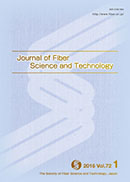
- |<
- <
- 1
- >
- >|
-
Hua Shen, Shaochen Jiang, Sachiko Sukigara2017 Volume 73 Issue 8 Pages 177-181
Published: August 10, 2017
Released on J-STAGE: August 09, 2017
JOURNAL OPEN ACCESSThickness and compression pressure play an important role in thermal sensation when a fabric is touched. In this work, we examine the temperature change inside furs and fabrics to simulate a finger pressing the surface of a fabric. In this study, a Kawabata finger sensor device was used to measure the temperature change (UTmax, ̊C/s), which is used to indicate the thermal sensation. The finger sensor unit was connected to a compression tester to change the compression pressure and obtain pressure-thickness curves. For artificial fur samples, the values of UTmax increased with the increase of maximum pressure for all samples. This suggests that when artificial fur is touched with a higher force, the contact feeling may be cooler than that when the fur is touched gently. For short pile lengths, UTmax was affected by the increase in pile length. For long pile lengths, UTmax was almost constant and independent of pile length. A linear relationship between the volume ratio of air and UTmax was observed when the pile length was long. When the thickness of the fur was small, the thickness had a large effect on the UTmax. For fabric samples, the effect of fiber conductivity on the UTmax was much larger than that of the thickness.
View full abstractDownload PDF (2053K) -
Roni Maryana, Akiko Nakagawa-izumi, Mikio Kajiyama, Hiroshi Ohi2017 Volume 73 Issue 8 Pages 182-191
Published: August 10, 2017
Released on J-STAGE: August 09, 2017
JOURNAL OPEN ACCESSThis study focuses on improving the quality of dissolving pulp (DP) from sugarcane bagasse (SB) prepared by a non-sulfur cooking method and totally chlorine-free (TCF) bleaching sequences. First, the effects of prehydrolysis and soda-anthraquinone (AQ) cooking conditions on brightness and viscosity were studied. Second, a novel five-stage TCF bleaching sequence, which employs oxygen (O) bleaching,peroxymonosulfuric acid (Psa) treatment and alkali extraction with hydrogen peroxide (Ep) in the sequence OPsa-Ep-Psa-Ep was applied to SB pulps. The maximum brightness and viscosity of unbleached pulp were 46.3% ISO and 34.1 cP, respectively, whereas after the final bleaching stage, the maximum qualities (brightness: 89.1% ISO, viscosity: 6.4 cP, glucan content: 95.7%, and ash content: 0.12%) met the standard requirements. For comparison, the effects of TCF bleaching on oil palm empty fruit bunch pulp were investigated. The proposed TCF bleaching shows a potential as a bleaching method to produce high-quality DP from SB.
View full abstractDownload PDF (756K) -
Shinji Kanehashi, Hiroki Oyagi, Kenji Ogino, Tetsuo Miyakoshi2017 Volume 73 Issue 8 Pages 192-201
Published: August 10, 2017
Released on J-STAGE: August 09, 2017
JOURNAL OPEN ACCESSNovel solvent-free bio-based hybrid coating and resin were prepared at room temperature from natural polyphenol compounds, natural lacquer (i.e., urushiol), and cashew nut shell liquid (CNSL). The biobased hybrids were fabricated by sol-gel and crosslink reactions among organic silane, urushiol, and CNSLbased epoxy compounds. The drying, hardness, and physical properties of the bio-based hybrids were investigated to determine the effective preparation condition. Prepolymerziation of epoxy cardanol and epoxy CNSL improved the molecular weight, drying, and hardness properties of the hybrids. The drying time until harden dry (HD) of the hybrids took about 1.3-6.0 hours at room temperature, which is faster than that of the hybrids prepared with commercial bisphenol A-type epoxy (BPAE). The hardness of the hybrids was greater than that of the hybrids prepared with BPAE. Therefore, the epoxy CNSL prepolymers can be effective to prepare the bio-based coating and resin materials compared with the BPAE-based hybrids.
View full abstractDownload PDF (2401K) -
Fengxin Sun, Zhaoqun Du, Weidong Yu, Chao Zhi, Nanliang Chen2017 Volume 73 Issue 8 Pages 202-209
Published: August 10, 2017
Released on J-STAGE: August 09, 2017
JOURNAL OPEN ACCESSA new tester is developed based on a quasi-fixed-supported beam system in this work. The new tester can characterize both warp and weft bending rigidity and assess the drape behaviour of fabrics in one test. A drape index, DI, was defined using the measured hanging lengths of warp and weft, and a linear model was also developed to predict the drape coefficient based on the measurement of the new tester. The calculus of variations was employed to calculate the bending rigidity by analysing the hanging shape of fabrics. Correlation between drape index, DI, and drape coefficient, DC as well as the bending rigidity measured by the new tester, KES-F2 and FAST-2 were estimated using linear regression analysis. The results showed that the new tester with calculus of variations could be used to evaluate the bending rigidity and drape behaviour of fabrics efficiently, and it also provided a useful method for real-time quality control of fabric bending and drape properties.
View full abstractDownload PDF (1588K)
- |<
- <
- 1
- >
- >|